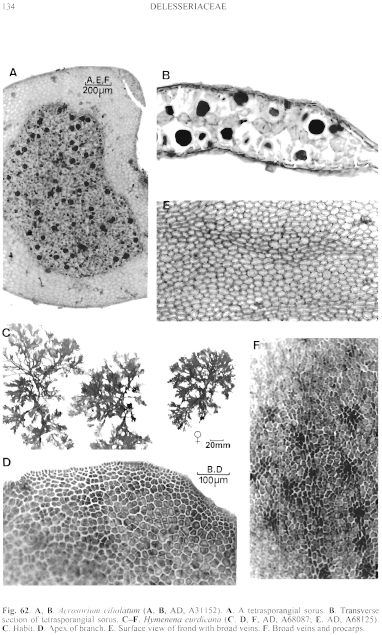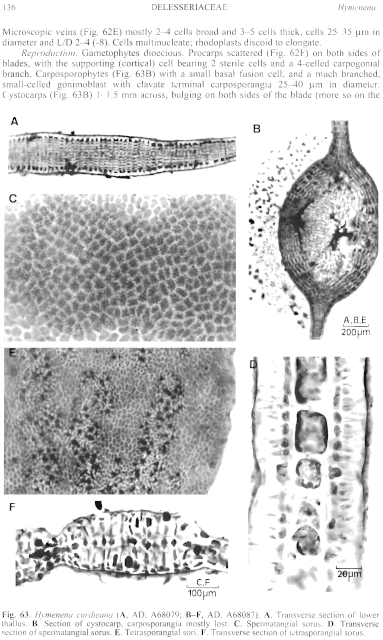|
|
|
|
|
|||||||||||
|
Electronic Flora of South Australia Species Fact Sheet
Phylum Rhodophyta – Family Delesseriaceae
Selected citations: Fuhrer et al. 1981: pls 29, 30. Guiler 1952: 101. Levring 1946: 226. Lucas & Perrin 1947: 223. May 1965: 401. Shepherd & Womersley 1981: 366. Womersley 1950: 184.
Synonyms
Nitophyllum curdieanum Harvey 1860: p1. 151; 1863, synop.: xxxii. J. Agardh 1872: 50; 1876: 458; 1898: 78. De Toni 1900: 658. Lucas 1909: 36; 1926: 606, pl. 45 fig. 2; 1929a: 19; 1929b: 50. Lucas & Perrin 1947: 223, figs 89, 90. Reinbold 1899: 46. Sonder 1880: 23. Tate 1882a: 20. Tepper 1883: 66. Tidall 1898: 509.
Cryptopleura curdieana (Harvey) Kützing 1869: 1, pl. 3.
Nitophyllum polyanthum J. Agardh 1876: 461; 1898: 77. De Toni 1900: 657. Guiler 1952: 102. Lucas 1909: 35; 1926: 606, pl. 45 fig. 1; 1929a: 19; 1929b: 50. Lucas & Perrin 1947: 223. Reinbold 1897: 54. Sonder 1880: 23. Tate 1882a: 20. Tisdall 1898: 509. Wilson 1892: 175.
Nitophyllum caulescens J. Agardh 1898: 70. De Toni 1900: 653. Lucas 1909: 35; 1926: 605.
Nitophyllum validum J. Agardh 1898: 78. De Toni 1900: 658. Lucas 1909: 36; 1926: 606; 1929b: 50. Lucas & Perrin 1947: 223.
Hymenena valida (J. Agardh) Kylin 1924: 79, fig. 62. May 1965: 401.
Thallus (Fig. 62C) light to dark red-brown, 10–20 (–25) cm high, much branched irregularly marginally and more-or-less complanately, upper branches alternately lobed, (2–) 4–10 mm broad but narrower basally, with rounded apices and margins usually slightly crispate, developing a thickened main axis and lower lateral branches, lower axes 2–4 mm broad, becoming covered with small proliferous bladelets; microscopic veins (Fig. 62E) coarse, irregularly branched, with the blade (especially on drying) becoming longitudinally corrugate between the veins. Holdfast 2–12 mm across, fibrous, branches compressed; epilithic. Structure. Growth marginal (Fig. 62D), without obvious apical cells, marginal cells 3–5 µm in diameter and L/D 1–2. Blades monostromatic near margins, becoming mostly 3 cells thick, cells 20–40 µm broad and L/D 1–2, with a broad midrib (Fig. 63A) developing below, 11–15 cells thick (cortex 5–7 cells thick, cells in anticlinal rows, similar in width).
Microscopic veins (Fig. 62E) mostly 2–4 cells broad and 3–5 cells thick, cells 25–35 µm in diameter and L/D 2–4 (–8). Cells multinucleate; rhodoplasts discoid to elongate.
Reproduction: Gametophytes dioecious. Procarps scattered (Fig. 62F) on both sides of blades, with the supporting (cortical) cell bearing 2 sterile cells and a 4-celled carpogonial branch. Carposporophytes (Fig. 63B) with a small basal fusion cell, and a much branched, small-celled gonimoblast with clavate terminal carposporangia 25–40 µm in diameter. Cystocarps (Fig. 63B) 1–1.5 mm across, bulging on both sides of the blade (more so on the ostiolate side). Pericarp 160–250 µm and 5–8 cells thick, cells in anticlinal rows. Spermatangial sori (Fig. 63C) on both sides of blades, more-or-less ovate, 0.7–1.2 mm across, 90–120 µm thick, with the cortical cells producing a layer of initials which cut off elongate spermatangia (Fig. 63D).
Tetrasporangial sori (Fig. 63E) ovate, 200–400 µm across and L/W 1–2 (–3), 130–200 µm thick, with 2 layers of tetrasporangia (Fig. 63F) cut off from inner cortical cells, and with outer cover cells which usually divide laterally; tetrasporangia subspherical, 45–55 µm in diameter.
Lectotype from S. Australia (Curdle); in Herb. Harvey, TCD.
Selected specimens: Elliston, S. Aust., drift (Womersley, 13.i.1951; AD, A13550-"Marine Algae of southern Australia" No. 110) and 7 m deep (Shepherd, 21.x.1970; AD, A37571). Gunyah Beach, Point Avoid, S. Aust., drift (Ricci, 12.ii.1994; AD, A63339). Port Elliot, S. Aust., drift (Womersley, 24.vii.1949; AD, A11140 and 10.viii.1957; A21153). Vivonne Bay, Kangaroo I., S. Aust., drift (Womersley, 2.i.1949; AD, A10622). Seal Bay, Kangaroo I., S. Aust., drift (Mitchell, 22.xi.1968; AD, A32950). 30 km SE of Cape Willoughby, Kangaroo I., S. Aust., 38 m deep (Bone, 13.iii.1989; AD, A59867). Cape Jaffa, S. Aust., drift (Womersley, 5.iv.1999; AD, A68079). Robe, S. Aust., drift (Womersley, 2.iv.1999; AD, A68125). Stinky Bay, Nora Creina, S. Aust., drift (Womersley, 21.xi.1998; AD, A67945). 1.3 km off Cape Northumberland, S. Aust., 15 m deep (Shepherd, 1.ii.1978; AD, A55280). Port MacDonnell, S. Aust., drift (Womersley, 4.iv.1999; AD, A68087-"Marine Algae of southern Australia" No. 110a). Narrawong Beach, Portland Bay, Vic., drift (Beauglehole, 15.v.1949; AD, A12092). Point Lonsdale, Vic., drift (Hansen, Jan 1955; AD, A20466).
Distribution: Elliston, S. Aust., to Point Lonsdale, Victoria.
Taxonomic notes: Hymenena curdieana is a common deep-water species on south-eastern coasts of South Australia, usually frequent in the drift. It is variable in habit but characterised by the lower thickened axes with proliferous bladelets on the surface, and especially by the coarse microscopic veins 2–4 cells broad.
H. curdieana has been recorded from New Zealand (see Adams 1994, p. 288). However Lindauer, Alg. Nova-Zel. Exsicc. 297, is doubtfully H. curdieana, differing in habit and the relatively slight veins.
Nitophyllum polyanthum J. Agardh [lectotype from Waterloo Bay, S. Aust., (O'Halloran) in Herb. Agardh, LD, 30877] and N. caulescens J. Agardh (lectotype from Encounter Bay, S. Aust., in Herb. Agardh, LD, 30809) are not separable from H. curdieana, as Kylin (1924, p. 29) considered. N. validum J. Agardh [H. valida (J. Agardh) Kylin], type from Port Phillip Heads, Vic. (Wilson, 27.i.1883, lectotype in Herb. Agardh, LD, 30580) is also within the range of H. curdieana.
References:
ADAMS, N.M. (1994). Seaweeds of New Zealand. (Cant. Univ. Press: Christchurch.)
AGARDH, J.G. (1872). Bidrag till Florideernes Systematik. Acta Univ. Lund 8, 1–60.
AGARDH, J.G. (1876). Species Genera et Ordines Algarum. Vol. 3, Part 1 - Epicrisis systematis Floridearum, pp. i-vii, 1–724. (Weigel: Leipzig.)
AGARDH, J.G. (1898). Species Genera et Ordines Algarum. Vol. 3, Part 3 - De dispositione Delesseriearum. (Gleerup: Lund.)
DE TONI, G.B. (1900). Sylloge Algarum omnium hucusque Cognitarum. Vol. 4. Florideae. Sect. 2. pp. 387–776. (Padua.)
FUHRER, B., CHRISTIANSON, I.G., CLAYTON, M.N. & ALLENDER, B.M. (1981). Seaweeds of Australia. (Reed: Sydney.)
GUILER, E.R. (1952). The marine algae of Tasmania. Checklist with localities. Pap. Proc. R. Soc. Tasmania 86, 71–106.
HARVEY, W.H. (1860). Phycologia Australica. Vol. 3, Plates 121–180. (Reeve: London.)
HARVEY, W.H. (1863). Phycologia Australica. Vol. 5, Plates 241–300, synop., pp. i-lxxiii. (Reeve: London.)
KÜTZING, F.T. (1869). Tabulae Phycologicae. Vol. 19. (Nordhausen.)
KYLIN, H. (1924). Studien über die Delesseriaceen. Lunds Univ. Årsskr. N.F. Avd. 2, 20(6), 1–111.
LEVRING, T. (1946). A list of marine algae from Australia and Tasmania. Acta Horti gothoburg 16, 215–227.
LUCAS, A.H.S. & PERRIN, F. (1947). The Seaweeds of South Australia. Part 2. The Red Seaweeds. (Govt Printer: Adelaide.)
LUCAS, A.H.S. (1909). Revised list of the Fucoideae and Florideae of Australia. Proc. Linn. Soc. N.S.W. 34, 9–60.
LUCAS, A.H.S. (1926). Notes on Australian marine algae. III. The Australian species of the genus Nitophyllum. Proc. Linn. Soc. N.S.W. 51, 594–607, Plates 37–45.
LUCAS, A.H.S. (1929a). The marine algae of Tasmania. Pap. Proc. R. Soc. Tasm. 1928, 6–27.
LUCAS, A.H.S. (1929b). A census of the marine algae of South Australia. Trans. R. Soc. S. Aust. 53, 45–53.
MAY, V. (1965). A census and key to the species of Rhodophyceae (red algae) recorded from Australia. Contr. N.S. W. Natl Herb. 3, 349–429.
REINBOLD, T. (1897). Die Algen der Lacepede und Guichen Bay und deren náherer Umgebung (Slid Australien), gesammelt von Dr. A. Engelhart-Kingston. Nuova Notarisia 8, 41–62.
REINBOLD, T. (1899). Meeresalgen von Investigator Street (Süd Australien), gesammelt von Miss Nellie Davey (Waltham, Honiton). Hedwigia 38, 39–51.
SHEPHERD, S.A. & WOMERSLEY, H.B.S. (1981). The algal and seagrass ecology of Waterloo Bay, South Australia. Aquat. Bot. 11, 305–371.
SONDER, O.W. (1880). In Mueller, F., Fragmenta Phytographiae Australiae. Supplementum ad volumen undecinum: Algae Australianae hactenus cognitae, pp. 1–42, 105–107. (Melbourne.)
TATE, R. (1882a). A list of the charas, mosses, liverworts, lichens, fungs, and algals of extratropical South Australia. Trans. R. Soc. S. Aust. 4, 5–24.
TEPPER, J.G.O. (1883). Botanical notes relating to South Australia. Trans. R. Soc. S. Aust. 6, 65–67.
TISDALL, H.T. (1898). The algae of Victoria. Rep. 7th Meet. Aust. Ass. Adv. Sci., Sydney, 1898, pp. 493–516.
WILSON, J.B. (1892). Catalogue of algae collected at or near Port Phillip Heads and Western Port. Proc. R. Soc. Viet. 4, 157–190.
WOMERSLEY, H.B.S. (1950). The marine algae of Kangaroo Island. III. List of Species 1. Trans. R. Soc. S. Aust. 73, 137–197.
The Marine Benthic Flora of Southern Australia Part IIID complete list of references.
Publication:
Womersley, H.B.S. (24 February, 2003)
The Marine Benthic Flora of Southern Australia
Rhodophyta. Part IIID. Ceramiales – Delesseriaceae, Sarcomeniaceae, Rhodomelaceae
Reproduced with permission from The Marine Benthic Flora of Southern Australia Part IIID 2003, by H.B.S. Womersley. Australian Biological Resources Study, Canberra. Copyright Commonwealth of Australia.
Illustrations in Womersley Part IIIA, 2003: FIGS 62 C–F, 63.

Figure 62 enlarge
Fig. 62. A, B. Acrosorium ciliolatum (A, B, AD, A31152). A. A tetrasporangial sorus. B. Transverse section of tetrasporangial sorus. C–F. Hymenena curdieana (C, D, F, AD, A68087; E. AD, A68125). C. Habit. D. Apex of branch. E. Surface view of frond with broad veins. F. Broad veins and procarps.

Figure 63 enlarge
Fig. 63. Hymenena curdieana (A, AD, A68079; B–F, AD, A68087). A. Transverse section of lower thallus. B. Section of cystocarp, carposporangia mostly lost. C. Spermatangial sorus. D. Transverse section of spermatangial sorus. E. Tetrasporangial sori. F. Transverse section of tetrasporangial sorus.

|
Email Contact: State Herbarium of South Australia |

|